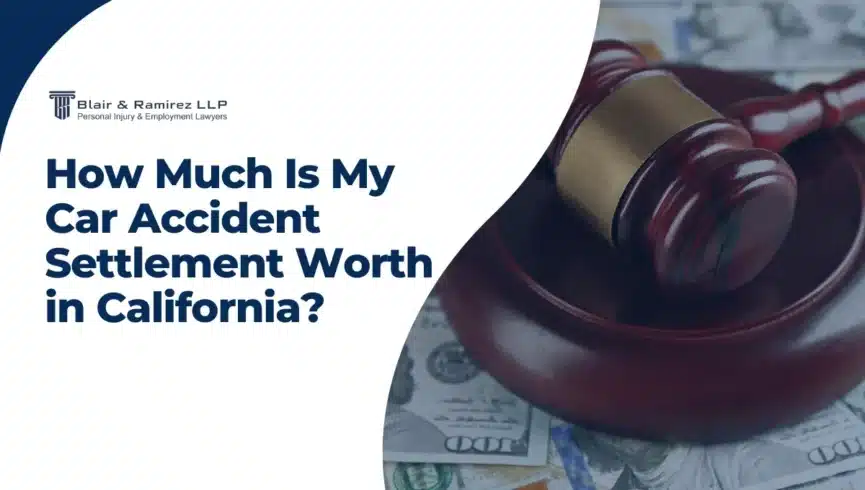When filing a car crash claim in California, many victims wonder about the average car accident settlement amount they can get. The reality is, there is no fixed figure. Settlements vary in each case, depending on several factors, including injury severity, fault, and available insurance coverage.
California settlements can range anywhere from a few thousand dollars for minor injuries to well over $1 million in catastrophic or fatal cases. Basically, your final payout depends on the valuation, documentation, and negotiation of the two core components: economic losses and non-economic damages.
Whether you’re wondering how much to expect from a car accident settlement or trying to figure out what a fair offer looks like, we’ll break down factors affecting settlement value and how insurance companies calculate it.
What Factors Determine the Value of a Car Accident Settlement?
Car accident settlements in California aren’t based on assumptions or subjective opinions. Insurance companies and personal injury lawyers calculate the value of a claim using a mix of legal, financial, and medical facts. The following factors affect not just the total compensation you may recover but also whether you get a fair offer at all.
Severity and Type of Injuries
The nature and severity of your injuries directly affect how much compensation you can recover. More serious injuries don’t just cause more pain. They disrupt daily life, require longer recovery periods, and lead to higher financial and emotional costs.
For example:
- Minor soft tissue injuries, such as whiplash, need few treatments and typically result in lower settlements.
- Broken bones, herniated discs, or nerve damage involve longer therapy and missed work, often increasing the claim’s value.
- Meanwhile, catastrophic injuries, like brain trauma or spinal cord damage, raise the stakes due to their lifelong impact on mobility, income, and independence.
California car accident settlements account for the lasting consequences of an injury, not just the immediate symptoms.

Medical Expenses and Future Treatment Costs
Medical expenses are the basis of economic damages claims. These encompass all past, present, and future treatment and care requirements. Medical costs that determine your final recovery include:
- Emergency and hospital bills
- Surgery, imaging, and diagnostic fees
- Rehabilitation, physical therapy, and follow-ups
- Prescription medications and assistive devices
- Psychiatric treatment, therapy sessions, or trauma counseling
In short, the total medical value of your case depends on both immediate care and long-term needs, including physical and emotional health.
Insurance Coverage and Policy Limits
Your compensation is often limited by policy caps, not just by how much your case is worth. In California, drivers must carry minimum liability insurance, but in many cases, those limits don’t fully cover serious injuries or long-term losses.
Here’s how coverage affects your settlement:
- The at-fault driver’s policy limits cap insurance payouts.
- Your own UM/UIM coverage can pay the difference if their insurance runs out.
- Additional policies, like umbrella coverage, may extend total available funds.

Shared Fault and Comparative Negligence
Under California’s pure comparative negligence rule, your percentage of fault directly reduces your total settlement value. If you’re partially responsible for the crash, the insurer or court will assign you a fault percentage and subtract that same percentage from your total car accident compensation.
For example, if your total damages equal $100,000, but you’re found 30% at fault, your final settlement drops to $70,000.
Even if you’re mostly responsible, California law still allows partial recovery, but the more fault assigned to you, the less compensation you’ll receive.
Emotional Distress and Mental Anguish
California law allows car accident victims to recover compensation for emotional and psychological harm. If the trauma from a crash disrupts your daily life, sleep, or mental health, it directly supports the value of your non-economic damages.
The extent of your emotional distress and credible evidence to prove it influences your final recovery. Compensable emotional damages include:
- Anxiety, depression, or PTSD
- Sleep disturbances, Insomnia, or nightmares
- Fear and phobias
To support this part of your claim, you’ll need therapy notes, psychiatric evaluations, or formal documentation that links your mental health condition to the accident.
How to Calculate Car Accident Settlements: Economic and Non-Economic Damages
Car accident compensation typically breaks down into two categories of recoverable losses: economic and non-economic. These categories reflect both your measurable financial losses and the subjective impact of the crash on your life.
To get a fair car accident settlement estimate, you need to calculate both types accurately and support them with strong documentation. Let’s explore what goes into each category and how insurance companies often assign value.
Medical Bills, Lost Wages, and Property Damage
Economic damages include all financial losses you can prove with records. These damages form the base of your claim and are typically the easiest to quantify.
- Medical Bills: hospital stays, doctor visits, surgeries, prescriptions, and physical therapy
- Lost Wages: income missed due to injury, treatment, or recovery time
- Property Damage: vehicle repair or replacement costs, rental car fees, or loss of use
You’ll need invoices, pay stubs, repair estimates, and receipts to validate each of these losses. Without proof, insurers may exclude them from your settlement.

Pain and Suffering: How It’s Measured
Pain and suffering settlement covers physical pain, daily life disruption, and the emotional impact of your injuries. Since it doesn’t come with a receipt, insurers estimate it based on the severity and duration of your recovery.
Key factors influencing this calculation:
- The seriousness of your injury and how long it took to heal
- Whether you experienced chronic pain, disfigurement, or long-term disability
- How the injury disrupt your ability to live normally
California insurers often use structured methods, such as the multiplier method, to translate pain and suffering into a dollar amount.
Loss of Enjoyment and Emotional Trauma Explained
Loss of enjoyment refers to your inability to participate in hobbies, daily routines, or relationships because of your injuries. This includes both physical limitations and emotional struggles that reduce your quality of life.
For instance, no longer being able to participate in sports or outdoor activities you once enjoyed, or withdrawing socially due to emotional trauma, anxiety, or fear related to driving.
These losses are part of your non-economic damages and must be supported with personal statements, mental health records, or testimony from people close to you.
Multiplier Method: Common Ranges and Examples
Insurance companies usually use the multiplier method to estimate intangible non-economic damages like pain and suffering.
Insurers multiply your total economic damages by a “multiplier” number (usually between 1.5 and 5) based on the seriousness of your injuries. This formula estimates the value of non-economic (or general) damages, which are then added together to calculate a total settlement.
For example:
- $10,000 in medical and wage losses × 1.5 = $15,000 total compensation (mild injury)
- $50,000 in economic damages × 4 = $200,000 total compensation (severe injury with lasting effects)
- $80,000 × 5 = $400,000 settlement (catastrophic injury or permanent disability)
The higher the impact on your life, the higher the multiplier and the more negotiation leverage your attorney can use.
How Insurance Companies Determine and Reduce Payouts
Insurance companies mostly do not calculate settlement payouts to help you recover everything you’ve lost. Their aim is usually to protect profit and limit what they pay, even in valid claims.
After an accident, your insurer and the at-fault party’s insurer will evaluate your injuries, property damage, and liability, but they may use various tactics to lower the claim value throughout the process.
Tactics Insurance Adjusters Use to Lower Settlements
Some common bad-faith insurance tactics adjusters use in California car accident claims include:
- Delaying communication to pressure you into accepting a low offer
- Downplaying your injuries by questioning treatment necessity
- Disputing liability to shift fault under comparative negligence
- Using your own statements to imply you’re not seriously injured
- Rushing a fast settlement before your full damages are known
These steps reduce your negotiating leverage. If you’re not prepared to counter, these strategies can reduce your final payout, even if your damages are well-documented.

Role of Recorded Statements and Medical Releases
Insurers frequently ask for a recorded statement or full medical release early in the process, but these requests aren’t in your favor. What you say or sign can weaken your claim and reduce your settlement value.
Adjusters may take even harmless statements (such as “I’m fine” or “I’m sorry”) out of context to suggest your injuries are not serious or that you’re at fault.
Medical releases can give them access to unrelated past conditions, which may be misused to deny or minimize coverage.
Never provide these resources without legal advice. A car accident attorney can guide you in communicating with insurers or lead conversations on your behalf.
Understanding Policy Exclusions and Coverage Gaps
Even with a strong claim, insurance policy exclusions and coverage gaps can cap our total recovery and leave you personally responsible for costs. Restriction conditions occur when your policy limits are insufficient or when certain risks aren't covered at all, such as:
- Intentional Acts Exclusion: If you intentionally caused the accident or committed fraud, such as purposefully damaging your car to collect a settlement.
- Unlisted Drivers: If the person driving the vehicle wasn’t listed on the policy
- Uninsured/Underinsured Motorists Coverage: If a driver with inadequate or no insurance causes an accident, your own UM/UIM coverage needs to pay for your damages.
Knowing your own policy and the other party’s coverage terms helps you understand the real limits of the payout.
California Liability Laws That Impact Settlement Amounts
Liability in a car accident in California follows specific car accident laws that directly influence the compensation you can recover. Even if you have strong evidence and documented damages, your settlement will drop if you're partially guilty under these rules.
Pure Comparative Fault: How It Works in California
California’s pure comparative fault system allows each party involved in a car crash to recover compensation, even if they share varying degrees of fault. This legal standard doesn't entirely disqualify the at-fault parties from recovery. Instead, it reduces the final payout in direct proportion to the percentage of fault.
How It Works:
- Insurance adjusters or a jury assess how much responsibility each driver holds
- Your share of the fault is stated as a %
- Total damages are calculated, and your compensation is reduced by your fault share
This standard applies in both insurance settlements and personal injury lawsuits, making it a core factor in all California car accident claims.
How Liability Percentages Affect Your Compensation
Liability percentages matter because they directly affect your final recovery amount. Simply, the higher your fault percentage, the lower your payout.
Let’s break down a quick comparison of how fault changes the payout amount in real terms:
| Calculating Reduced Settlements Due to Shared Fault | ||
|---|---|---|
| Total Damages | Your Fault % | Final Settlement |
| $100,000 | 0% | $100,000 |
| $100,000 | 20% | $80,000 |
| $100,000 | 50% | $50,000 |
| $100,000 | 75% | $25,000 |
Knowing this rule helps you evaluate how much your car accident case is worth, especially when liability is disputed.
Average Settlement Amounts for Common Car Accident Injuries in California
While every case is different, statewide trends can help you estimate your potential car accident settlement payouts. These numbers reflect past case results in California and offer a helpful reference point when comparing injury severity and recovery amounts.
| Estimated Averages by Injury Type | |||
|---|---|---|---|
| Tier | Injury Type | Examples | Typical Settlement Range |
| Tier 4: Minor | Soft Tissue Injuries | Whiplash, sprains, muscle strains | $5,000 – $25,000 |
| Tier 3: Moderate | Broken Bones or Joint Injuries | Fractures, dislocations, torn ligaments | $25,000 – $100,000 |
| Moderate Neck or Back Injury | Muscle damage, disc strain, limited mobility | $30,000 – $100,000 | |
| Tier 2: Severe | Spinal Injuries / Herniated Discs | Disc bulges, nerve impingement, chronic pain | $75,000 – $250,000+ |
| Traumatic Brain Injuries (TBI) | Memory loss, and long-term cognitive impairment | $150,000 – $1,000,000+ | |
| Tier 1: Catastrophic / Fatal | Severe Disability or Paralysis | Spinal cord damage, full or partial paralysis | $500,000 – $1,000,000+ |
| Wrongful Death Claims | Fatal outcome; claim filed by family members | $500,000 – $1,000,000+ | |
Note: These are not guaranteed amounts. Outcomes depend on medical documentation, fault percentage, available insurance coverage, and legal strategy.
How to Estimate Your Car Accident Settlement Value in California
To make a rough estimate of your car accident settlement, you must combine your documented financial losses with a reasonable calculation of non-economic damages, like pain and suffering under Civil Code § 1431.2.
Here are 4 practical ways to estimate your potential case value:
- Use a Car Accident Settlement Calculator: Input your medical bills, lost income, and injury severity to generate a starting estimate. But use caution, as these tools often exclude legal and liability factors.
- Compare Your Case to Similar Past Settlements: Look for California personal injury claims with similar injuries, treatment timelines, and fault situations.
- Consult with Medical and Financial Experts: Professionals can project future medical care costs, loss of earning capacity, and long-term health needs, which are essential for high-value cases.
- Get a Case Evaluation from a Car Accident Lawyer: An attorney will review your crash details, injury documentation, and applicable insurance coverage to provide a realistic and legally grounded case value.
These steps help you avoid guessing whether the offer is fair and dodge a lowball settlement that undervalues your recovery.
How to Maximize Your Car Accident Settlement Legally and Strategically
To increase the value of your car accident settlement in California, you must protect your claim from the start. Insurance companies will reduce your payout if you miss documentation, delay treatment, or handle negotiations without legal support.
Focus on these three areas to build a strong, credible case:
Documenting Injuries with Strong Medical Records
Medical records are central to calculating your car accident settlement. You must show clear, consistent treatment tied directly to the crash.
To strengthen your case:
- Get treatment immediately after the accident
- Follow up with all prescribed care, including specialists
- Request detailed diagnosis reports and treatment notes
- Obtain a Maximum Medical Improvement (MMI) report when applicable
Preserving Crash Scene and Witness Evidence
Physical and testimonial evidence proves fault and realistically values damages. Take these steps that support your version of events and strengthen your car accident claim:
- Photograph the vehicles, skid marks, debris, and visible injuries
- Secure the police report and crash diagram
- Collect names and contact info of all witnesses
- Keep all records of repair costs and rental vehicles
Without early documentation, time-sensitive evidence may disappear, and insurers may dispute liability or downplay impact.
Choosing the Right Car Accident Lawyer in California
Legal representation directly affects your settlement outcome, especially when the case involves severe injuries, shared fault, and insurance pressure. An experienced auto accident lawyer understands local laws, insurance tactics, and strategies to maximize the case value.
Hire a lawyer with:
- A focus on personal injury and auto accident claims
- Proven results in negotiation and litigation
- A contingency fee model (no-win, no-fee)
- Strong communication and case management

Overlooked Damages You May Be Entitled to Claim
Many California car accident victims settle without realizing they can recover more than just medical bills or vehicle damage. If documented properly, these less obvious losses may increase your total car accident compensation.
Here are additional damages you may be entitled to include:
- Loss of Consortium: Compensation for how the accident impacted your relationship or family life
- Diminished Earning Capacity: If your injuries reduce your future ability to work or earn income
- Long-Term Mental Health Treatment: Costs of ongoing therapy, psychiatric care, or emotional trauma counseling
- Home or Vehicle Modifications: Accessibility changes required due to permanent injuries (e.g., wheelchair ramps)
- In-Home Care or Support Services: Personal assistance required during recovery or after a disability diagnosis
Including these damages in your claim can raise your settlement value calculation significantly. However, each of these must be supported with medical records, expert reports, or financial documentation.
How Car Accident Settlements Are Valued in California
In California, insurance companies and personal injury lawyers value car accident settlements by evaluating 3 core components:
- Documented economic losses (e.g., medical bills, lost wages, property damage)
- Estimated non-economic damages (e.g., pain, suffering, emotional distress)
- Liability assessment (based on fault percentage under comparative negligence rules)
To calculate your potential payout, insurers evaluate your medical records, crash evidence, and financial documentation to assign value.
Step-by-Step Breakdown of the California Car Accident Settlement Process
Your car accident settlement follows a structured legal and insurance timeline, and each step helps you understand how your claim is valued and where delays or reductions may happen.
Filing a Claim and Gathering Evidence
You must notify your insurance company promptly, usually within 24 to 72 hours or as your policy states. In case the accident caused injury, death, or over $1,000 in property damage, you must also file a DMV SR-1 form within 10 days. Then, gather all facts and preserve early evidence to support your claim.
Negotiating with the Insurance Company
Once you submit your evidence and demand letter, the insurer will review your case and issue a settlement offer. Most initial offers are low, and to negotiate better, respond with detailed evidence and refuse to settle until treatment is complete. Let your attorney handle communication to avoid mistakes.
When and Why to File a Personal Injury Lawsuit
If the insurer delays, denies liability, or offers an unreasonably low payout, filing a personal injury lawsuit may be necessary. You should consider litigation when:
- The statute of limitations is approaching (2 years in CA for injury claims)
- The insurance company refuses to cover clear damages
- You face long-term losses that require expert testimony
- Fault is disputed and cannot be resolved in negotiation
A lawsuit often leads to more serious negotiation or court-ordered compensation, especially in high-value or complex injury cases.
Frequently Asked Questions About Car Accident Settlements in California (FAQs)
Know the True Worth of Your Settlement Before Accepting an Offer
In California, your car accident compensation depends on more than one thing. Your injury, its medical and emotional impact, related financial losses, accessible insurance coverage, and your share of fault under the law all accumulate to form your final recovery.
A quick offer usually reflects the insurance company’s best interests, not yours. Never accept a settlement without understanding its full value. Before you sign anything, consult a legal expert to evaluate your case realistically and ensure you recover the full amount you’re legally entitled to.

Tell Us What Happened - We’re Ready to Help


